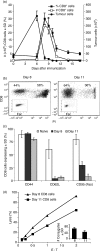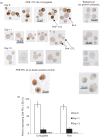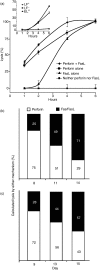Switch from perforin-expressing to perforin-deficient CD8(+) T cells accounts for two distinct types of effector cytotoxic T lymphocytes in vivo
- PMID: 19689737
- PMCID: PMC2747140
- DOI: 10.1111/j.1365-2567.2009.03072.x
Switch from perforin-expressing to perforin-deficient CD8(+) T cells accounts for two distinct types of effector cytotoxic T lymphocytes in vivo
Abstract
Although CD8(+) cytotoxic T lymphocytes (CTL) exhibit both Fas ligand (FasL) -based and perforin-based lytic activities, the accepted hallmark of a fully active CTL remains its perforin killing machinery. Yet the origin, rationale for possessing both a slow-acting (FasL) and a fast-acting (perforin) killing mechanism has remained enigmatic. Here we have investigated perforin expression in CTL directly involved in acute tumour (i.e. leukaemias EL4 and L1210) allograft rejection occurring within the peritoneal cavity. We show that at the height of the immune response, the majority of conjugate-forming CD8(+) CTL express high levels of perforin messenger RNA and protein, and kill essentially via perforin. Later however, coinciding with complete rejection, fully cytocidal CTL emerge which exhibit a stark decrease in perforin and now kill preferentially via constitutively expressed FasL. Although late in emergence, and persistent, these powerful CTL are neither effector-memory nor memory CTL. This finding has implications for the monitoring of anti-transplant responses in clinical settings, based on assessing perforin expression in graft infiltrating CD8(+) T cells. The results show that as the immune response progresses in vivo, targeted cellular suicide mainly prunes high perforin-expressing CD8(+) cells, resulting in the gradual switch in effector CTL, from mostly perforin-based to largely Fas/FasL-based killers. Hence, two kinds of CD8(+) CTL have two killing strategies.
Figures










Similar articles
-
Acute rejection of allografted CTL-susceptible leukemia cells from perforin/Fas ligand double-deficient mice.J Immunol. 2007 Aug 15;179(4):2180-6. doi: 10.4049/jimmunol.179.4.2180. J Immunol. 2007. PMID: 17675477
-
Tumor-specific CTL kill murine renal cancer cells using both perforin and Fas ligand-mediated lysis in vitro, but cause tumor regression in vivo in the absence of perforin.J Immunol. 2002 Apr 1;168(7):3484-92. doi: 10.4049/jimmunol.168.7.3484. J Immunol. 2002. PMID: 11907109
-
Immunosensitization of melanoma tumor cells to non-MHC Fas-mediated killing by MART-1-specific CTL cultures.J Immunol. 2001 Mar 1;166(5):3564-73. doi: 10.4049/jimmunol.166.5.3564. J Immunol. 2001. PMID: 11207317
-
Th2 and Tc2 cells in the regulation of GVHD, GVL, and graft rejection: considerations for the allogeneic transplantation therapy of leukemia and lymphoma.Leuk Lymphoma. 2000 Jul;38(3-4):221-34. doi: 10.3109/10428190009087014. Leuk Lymphoma. 2000. PMID: 10830730 Review.
-
Mechanism and biological significance of CD4-mediated cytotoxicity.Immunol Rev. 1995 Aug;146:57-79. doi: 10.1111/j.1600-065x.1995.tb00684.x. Immunol Rev. 1995. PMID: 7493761 Review.
Cited by
-
Overcoming on-target, off-tumour toxicity of CAR T cell therapy for solid tumours.Nat Rev Clin Oncol. 2023 Jan;20(1):49-62. doi: 10.1038/s41571-022-00704-3. Epub 2022 Nov 23. Nat Rev Clin Oncol. 2023. PMID: 36418477 Free PMC article. Review.
-
Killing Mechanisms of Chimeric Antigen Receptor (CAR) T Cells.Int J Mol Sci. 2019 Mar 14;20(6):1283. doi: 10.3390/ijms20061283. Int J Mol Sci. 2019. PMID: 30875739 Free PMC article. Review.
-
Alloprimed CD8(+) T cells regulate alloantibody and eliminate alloprimed B cells through perforin- and FasL-dependent mechanisms.Am J Transplant. 2014 Feb;14(2):295-304. doi: 10.1111/ajt.12565. Am J Transplant. 2014. PMID: 24472191 Free PMC article.
-
Advances in CAR T-cell therapy in bile duct, pancreatic, and gastric cancers.Front Immunol. 2022 Oct 6;13:1025608. doi: 10.3389/fimmu.2022.1025608. eCollection 2022. Front Immunol. 2022. PMID: 36341440 Free PMC article. Review.
-
Cytotoxic Efficiency of Human CD8+ T Cell Memory Subtypes.Front Immunol. 2022 Apr 13;13:838484. doi: 10.3389/fimmu.2022.838484. eCollection 2022. Front Immunol. 2022. PMID: 35493468 Free PMC article.
References
-
- Cerottini JC, Brunner KT. Cell-mediated cytotoxicity, allograft rejection, and tumor immunity. Adv Immunol. 1974;18:67–132. - PubMed
-
- Kägi D, Ledermann B, Burki K, Zinkernagel RM, Hengartner H. Molecular mechanisms of lymphocyte-mediated cytotoxicity and their role in immunological protection and pathogenesis in vivo. Annu Rev Immunol. 1996;14:207–32. - PubMed
-
- Trapani JA, Smyth MJ. Functional significance of the perforin/granzyme cell death pathway. Nat Rev Immunol. 2002;2:735–47. - PubMed
-
- Henkart PA, Catalfamo M. CD8+ effector cells. Adv Immunol. 2004;83:233–52. - PubMed
-
- Berke G, Clark W. Killer lymphocytes. Berlin: Springer; 2005.
Publication types
MeSH terms
Substances
LinkOut - more resources
Full Text Sources
Other Literature Sources
Research Materials
Miscellaneous

